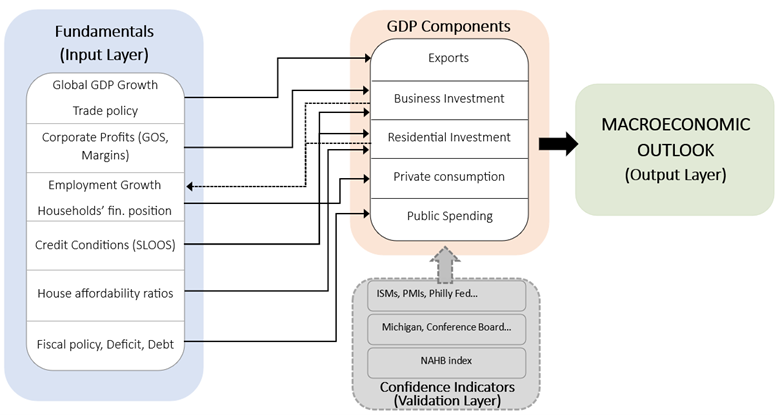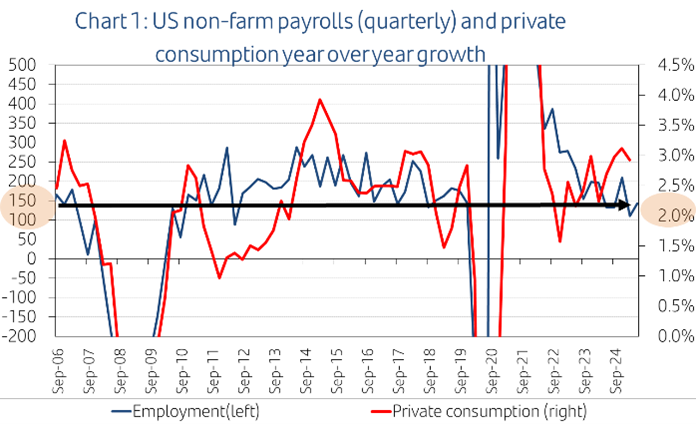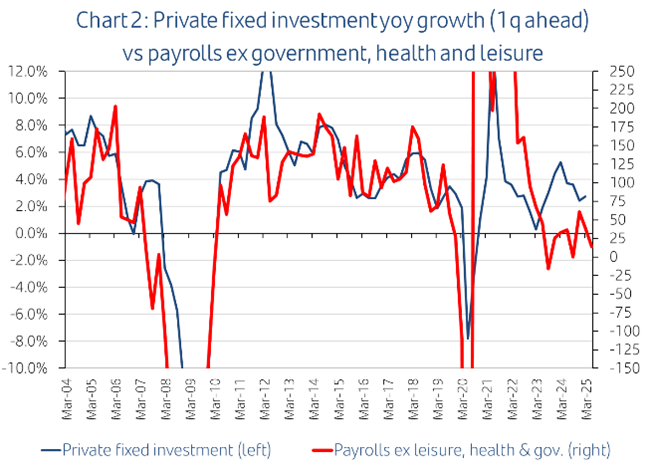Investment and Consumption Fundamentals: Cornerstones of the Macroeconomic Framework
In the first installment of our three-part series, we emphasized the crucial role of identifying the key fundamentals underpinning the various components of GDP. These fundamentals form the backbone of our macroeconomic framework.
In this second installment, we turn our attention to those key drivers across four critical components: business investment, residential investment, structures investment, and private consumption. The first three are particularly important in shaping employment growth, which, in turn, is the primary determinant of private consumption. This latter component represents the largest share of GDP across Developed Economies—especially in the United States.
While business investment may carry less absolute weight in the economy, it holds the strongest correlation with GDP growth. Its volatility tends to anticipate cyclical turning points, reflecting its deep linkage to employment trends. For this reason, especially in the U.S., our analytical process often begins with a detailed assessment of the medium-term fundamentals shaping business investment.
These fundamentals fall broadly into two interconnected categories: credit conditions for non-financial corporates and the financial position of those firms. On the credit front, we closely monitor the Senior Loan Officer Opinion Survey (SLOOS), paying particular attention to standard lending criteria and credit demand. On the financial health side, our focus includes metrics such as corporate and non-corporate profits, gross operating surplus (GOS), and the so-called financing gap—defined as the difference between capital expenditures and internally generated funds, indicating whether firms are net borrowers or savers.
To look forward, we go beyond current readings and assess the potential trajectory of these variables. For instance, GOS can be deconstructed into Gross Value Added (GVA), employee compensation, interest payments, and tax payments. To estimate the margin between GVA and labor costs, we use profit margins as a proxy. Specifically, we define margins as the spread between output prices (CPI inflation) and input costs—particularly unit labor costs (ULC), which capture the gap between wage growth and productivity. Compression in these margins—whether driven by falling CPI or rising ULC—often signals an upcoming decline in GOS and, by extension, in capital expenditures.
For the remaining components of GOS, we examine the trajectory of medium-term yields and central bank policy rates to forecast interest payments, while current tax policy gives us insight into potential shifts in tax payments. Disaggregating these dynamics enables a more granular view of corporate financial resilience and investment prospects.
Compared to business investment, residential investment plays a smaller role in shaping GDP outcomes. Its correlation with GDP is lower, and it tends to react to, rather than lead, broader macroeconomic trends. Still, we view it as a meaningful indicator of cyclical momentum.
Here, too, we rely on SLOOS—particularly indicators related to mortgage credit standards and demand—as well as on measures of housing affordability and mortgage accessibility. These fundamentals provide insight into near-term risks or supports to residential investment.
The third investment category, structures, also carries limited influence over GDP dynamics. Nonetheless, we track it through key drivers such as commercial real estate lending standards (SLOOS) and public policy initiatives like the Inflation Reduction Act (IRA) and the CHIPS Act. These fiscal measures have directed significant investment into targeted sectors via subsidies, tax credits, and direct expenditure.
Having covered the three investment components, we now pivot to their key transmission channel—employment. Employment acts as the crucial bridge between capital spending and private consumption. Indeed, among all consumption drivers, employment is paramount (chart 1).
Among labor market indicators, we consider non-farm payrolls growth to be the most telling metric for capturing the direct link between investment and private consumption—far more so than indicators like the unemployment rate. However, it’s important to recognize that not all employment sectors are equally sensitive to capital spending dynamics.
In contrast, employment in sectors such as government and healthcare—and to a lesser extent, leisure—tends to grow steadily over time, largely independent of fluctuations in investment. These patterns have diverged further in recent years, especially following the COVID-19 outbreak, which altered the monthly pace of job gains in these areas.
This distinct trajectory matters. While these sectors are not tightly coupled with investment, they nonetheless exert a meaningful influence on private consumption due to their substantial contribution to total employment—over 30%. Recognizing this divergence is crucial to accurately interpreting labor market trends within the broader macroeconomic framework (chart 2).
Beyond employment, we highlight two additional variables shaping private consumption: consumer credit conditions and household financial health. Again, SLOOS provides insight into the former—specifically bank willingness to extend consumer loans and credit card availability. For the latter, we assess household saving rates in historical context, net lending/borrowing positions, and balance-sheet-derived net wealth.
With this review, we have outlined the key macroeconomic fundamentals that govern investment and consumption—forming the core pillars of our analytical macroeconomic framework. In the third and final installment of this series, we will conclude our framework by addressing the remaining GDP components: government expenditure and the external sector. We will then integrate all elements into a unified structure for tracking and forecasting economic cycles.
Discover our latest articles
Important legal information
This report has been prepared by Santander Asset Management (hereinafter “SAM”). SAM is the functional name of the asset management business conducted by the legal entity SAM Investment Holdings S.L. and its branches, subsidiaries and representative offices. This document contains economic forecasts and information gathered from several sources. The information contained in this document may have also been gathered from third parties. All these sources are believed to be reliable, although the accuracy, completeness or update of this information is not guaranteed, either implicitly or explicitly, and is subject to change without notice. Any opinions included in this document may not be considered as irrefutable and could differ or be, in any way, inconsistent or contrary to opinions expressed, either verbally or in writing, advices, or investment decisions taken by other areas of SAM. This report is not intended to be and should not be construed in relation to a specific investment objective. This report is published solely for informational purposes. This report does not constitute an investment advice, an offer or solicitation to purchase or sell assets, services, financial contracts or other type of contracts, or other investment products of any type (collectively, the “Financial Assets”), and should not be relied upon as the sole basis for evaluating or assessing Financial Assets. Likewise, the distribution of this report to a client, or to a third party, should not be regarded as a provision or an offer of investment advisory services. SAM makes no warranty in connection with any market forecasts or opinions, or with the Financial Assets mentioned in this report, including with regard to their current or future performance. The past or present performance of any markets or Financial Assets may not be an indicator of such markets or Financial Assets future performance. The Financial Assets described in this report may not be eligible for sale or distribution in certain jurisdictions or to certain categories or types of investors. Except as otherwise expressly provided for in the legal documents of a specific Financial Assets, the Investment Products are not, and will not be, insured or guaranteed by any governmental entity, including the Federal Deposit Insurance Corporation. They are not an obligation of, or guaranteed by, Santander, and may be subject to investment risks including, but not limited to, market and currency exchange risks, credit risk, issuer and counterparty risk, liquidity risk, and possible loss of the principal invested. In connection with the Financial Advisors, investors are recommended to consult their financial, legal, tax and other advisers as such investors deem necessary to determine whether the Financial Assets are suitable based on such investors particular circumstances and financial situation. Santander, their respective directors, officers, attorneys, employees or agents assume no liability of any type for any loss or damage relating to or arising out of the use or reliance of all or any part of this report. Past performance does not predict future returns. The returns may increase or decrease as a result of currency fluctuations relative to the respective investors’ domestic currency. Any reference to taxation should be understood as depending on the personal circumstances of each investor and which may change in the future. Costs incurred for purchasing, holding or selling Financial Assets may reduce returns and are not reflected in this report. This report may not be reproduced in whole or in part, or further distributed, published or referred to in any manner whatsoever to any person, nor may the information or opinions contained therein be referred to without, in each case, the prior written consent of SAM. Any third-party material (including logos, and trademarks), whether literary (articles/ studies/ reports, etc. or excerpts thereof) or artistic (photos/graphs/drawings, etc.), included in this report is registered in the name of its respective owner and only reproduced in accordance with honest industry and commercial practices.





